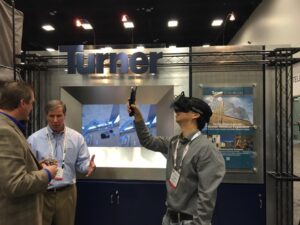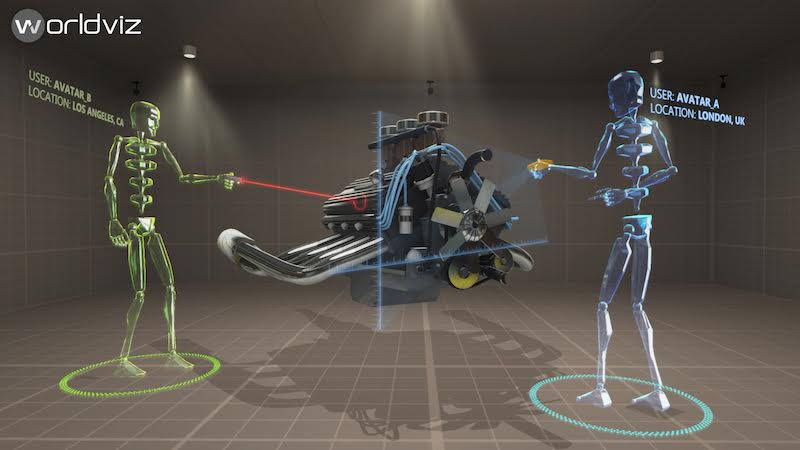After the consumer hype cools off in 2017, the focus for VR will shift from games and entertainment to industrial use.
By Andrew Beall, CEO of WorldViz
One of the big tech questions on everyone’s mind for 2017 is — Will business VR surpass consumer VR? Back in April of 2016, Fortune Magazine stated that by some estimates, the VR market would be worth $150 billion within four years. According to Nvidia: “VR is going to touch every industry from gaming to automotive to entertainment…” These estimations beg the bigger question: will it be consumers that drive growth in the use of VR, or will it be businesses? We believe it will be business.

That opinion comes from not only our long history and experience selling VR solutions to industry, but also from a number of outside sources. Forrester Research Group predicts, “Companies will continue to experiment with AR/VR, setting the foundation for larger implementations in 2018 and 2019.” According to Digi-Capital, virtual reality is the 4th technology wave, behind PC, Internet, and Mobile, and is on the verge of crossing the chasm from the “early adopters/enthusiasts” to the “pragmatists” or early majority. Market Research firm SuperData doesn’t foresee the VR market growing to nearly the size that Fortune Magazine estimates, but it does agree that sales of VR software and hardware will shift from consumers to businesses. “Of the VR software sales in 2016, [SuperData] said about 72 percent of the $407 million would be from games. By 2020, that percentage will fall to about 41 percent as enterprise, media, and other categories rise. With hardware revenue added, the forecast hits about $28 billion by 2020.”
As we move into 2017, businesses should be focusing on how to onboard and implement virtual reality applications so they’ll be well positioned for the “lift off” phase in 2018. According to Forrester Research, “Companies are already putting some of their big budgets into VR. Starting next year, businesses will buy more mid-priced virtual reality gear than consumers will.” Why? Simply stated, to stay competitive.
So, where will we see VR emerge in business? Having been involved with VR since the early 1990’s, we’ve seen businesses use VR in every phase of the product lifecycle. It’s here that we think VR will continue to make its greatest impact.
If you think of the product lifecycle as four stages — conceive, design, realize, and service — VR has and will continue to add value to each. Here’s how:
- In the “Conceive” phases, VR brings imagination to life. It provides rich, realistic contextual information early on, allowing companies to explore design alternatives without the cost and time penalties of physical prototypes.
- Once conceived, VR can also lend value to “Design” iterations by bringing rapid cycles of proof-of-concept testing and design iterations without the slowdowns of lab or field tests.
- VR can also lend itself to the product “Realization” phases by enabling companies to anticipate manufacturing and enrich the sales process. With VR, companies can visualize manufacturing workflows and eliminate production line bottlenecks. VR as a sales tool enables companies to create captivating sales presentations and build brand connection.
- As products get rolled out to the field, VR can assist companies in the “Service” phase with pre-training for maintenance and support. Training with VR improves retention as teams get trained on virtual products that mirror real products. It also cuts down costs since field personnel don’t have to travel to a physical location to be trained.
The one word that best encapsulates all of these areas is “communication”. Whether it’s visually communicating designs or communicating the value of a product in a sales meeting, VR is the perfect tool. Why? Because accurately conveying visual ideas to remote decision-makers is still a huge challenge for companies. We see it all the time — modern communication technologies such as telephony, video conference calls, and 2D PowerPoint sharing simply cannot bring people together in a collaborative setting or enable decision makers to experience complex 3D concepts, designs, and spaces first hand. VR changes all of that!
Last November, we announced our VR communication platform, codenamed Skofield, which allows multiple people to explore models in the same virtual space. It takes into account what we hear from our customers about their business challenges and couples that with what we know VR is capable of delivering — a means for revolutionizing business communications. Variations of this idea have been interesting to business for some time and companies have used CAVEs, they’ve experimented with shared 3D spaces like Second Life, and they’ve worked with expensive high definition video conferencing rooms, but VR has the potential to bring the best of these technologies together at a lower cost and in convenient, portable form factors. .

The ultimate result, of course, is time and money saved. Many industries, including aerospace, medical, and oil/gas, are spending an astronomical $1.25 trillion globally just on business travel so their teams can present and share ideas or other vital information face-to-face. VR allows companies to virtually travel to any location for a fraction of the cost, and in some cases, has proved even more effective.
Now more than ever, industries such as architecture, engineering, and construction are realizing the value of powerful communication tools that bring to life complex 3D objects, such as buildings, machines, cars, and engines, for their shareholders and consumers to experience. We believe it is only a matter of time before VR becomes standard practice and solidifies its permanent place in industry.
About Andrew Beall
Andrew C. Beall is CEO and CTO of WorldViz, a global Virtual Reality software and hardware provider. He earned his PhD in cognitive psychology at the University of California, Santa Barbara, in 1997. As a co-founder of WorldViz in 2002, his vision has helped the company become a leading turnkey interactive virtual reality solution provider for Fortune 500 industrial customers as well as numerous government agencies. Dr. Beall also co-directs the Research Center for Virtual Environments and Behavior at the University of California Santa Barbara’s Department of Psychology. He has received funding from the National Science Foundation, National Institutes of Health, Air Force Office of Scientific Research, the Office of Naval Research, and the Army Research Office. His research interests include visual psychophysics, collaborative virtual environments, and advanced displays and controls.






